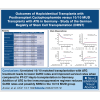Outcomes of haploidentical transplants with PT-CY vs 10/10 MUD transplants with ATG in Germany
- PMID: 39368803
- PMCID: PMC11652758
- DOI: 10.1182/bloodadvances.2024013719
Outcomes of haploidentical transplants with PT-CY vs 10/10 MUD transplants with ATG in Germany
Abstract
Allogeneic hematopoietic stem cell transplantation (allo-HSCT) is the best curative treatment modality for many malignant hematologic disorders. In the absence of a matched related donor, matched unrelated donors (MUDs) and haploidentical donors are the most important stem cell sources. In this registry-based retrospective study, we compared the outcomes of allo-HSCTs from 10/10 MUDs with antithymocyte globulin (ATG)-based regimens (n = 7050) vs haploidentical transplants (Haplo-Tx) using posttransplant cyclophosphamide (PT-CY Haplo; n = 487) in adult patients with hematologic malignancies between 2010 and 2020. Cox proportional hazard-and competing risks regression models were formed to compare the outcomes. Overall survival (OS), Disease-free survival (DFS), and graft-versus-host disease (GVHD)-free and relapse-free survival (GRFS) were superior for 10/10 MUDs (OS [hazard ratio (HR), 1.27; 95% confidence interval (CI), 1.10-1.47; P = .001]; DFS [HR, 1.17; CI, 1.02-1.34; P = .022]; GRFS [HR, 1.34; CI, 1.19-1.50; P < .001]). The risk of acute GVHD (aGVHD) grade 2 to 4, aGVHD grade 3 to 4, and chronic GVHD (cGVHD) was higher in the PT-CY Haplo group than the 10/10 MUD group (aGVHD grade 2-4 [HR, 1.46; CI, 1.25-1.71; P < .001]; aGVHD grade 3-4 [HR, 1.74; CI, 1.37- 2.20; P < .001]; cGVHD [HR, 1.30; CI, 1.11-1.51; P = .001]). A lower incidence of relapse was observed in the PT-CY Haplo group (relapse: HR, 0.83; CI, 0.69-0.99; P = .038). Unrelated 10/10 matched transplantation with ATG leads to lower GVHD rates and improved survival rates compared with PT-CY Haplo transplantation in Germany.
© 2024 by The American Society of Hematology. Licensed under Creative Commons Attribution-NonCommercial-NoDerivatives 4.0 International (CC BY-NC-ND 4.0), permitting only noncommercial, nonderivative use with attribution. All other rights reserved.
Conflict of interest statement
Conflict-of-interest disclosure: R.Z. received honoraria from Novartis, Incyte, Mallinckrodt Pharmaceuticals, Sanofi, medac, and Neovii. The remaining authors declare no competing financial interests.
A complete list of the members of the German Registry of Stem Cell Transplantation study group appears in “Appendix.”
Figures






References
-
- Copelan EA. Hematopoietic stem-cell transplantation. N Engl J Med. 2006;354(17):1813–1826. - PubMed
-
- Kekre N, Antin JH. Hematopoietic stem cell transplantation donor sources in the 21st century: choosing the ideal donor when a perfect match does not exist. Blood. 2014;124(3):334–343. - PubMed
-
- Ballen KK, Koreth J, Chen YB, Dey BR, Spitzer TR. Selection of optimal alternative graft source: mismatched unrelated donor, umbilical cord blood, or haploidentical transplant. Blood. 2012;119(9):1972–1980. - PubMed
MeSH terms
Substances
LinkOut - more resources
Full Text Sources

